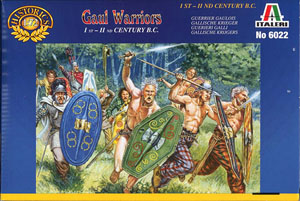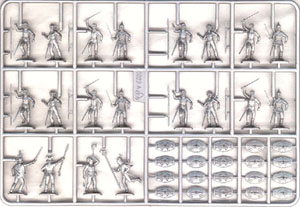Italeri Gaul Warriors Ist-IInd century BC - A Review by Stephen Montague
Text by Stephen Montague, Scans by Nick Grant
The box contains 40 figures. There are four basic figures which you get nine each of and four special figures. All figures have separate shields. You get two types of shield oval, which there are 26 of and hexagonal, which you get 24 of.
That's the basic information but now to the important bit what they are like! The four basic types are:-
- A running figure wearing a basic helmet and thrusting a (seperate)spear.
- A standing figure with a (seperate) spear.
- A running naked swordsman.
- A walking armoured swordsman.
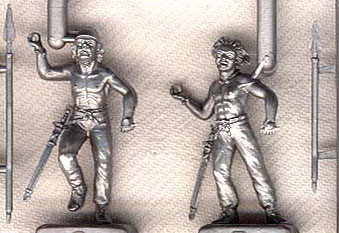 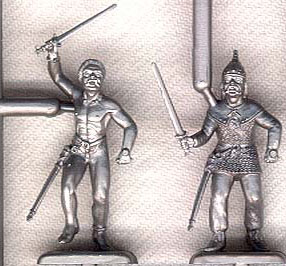
All are well detailed with good poses. The running spear man and the armoured swordsman are a little on the pedestrian side but the naked warrior is more vigorous pose. The best of the lot is the second spearman with his arm drawn back to thrust or throw. The sculpting of head is superb with a very expressive face and hair that captures the movement well. The detail on the swords and jewellery is also superb. The spears are superb, not the old generic spear type weapon you use to get, but recognisable spears, they are in two different lengths to give some variety.
The four special figures are:-
- A musician.
- A standard bearer.
- An unarmoured spear man.
- An armoured swordsman.
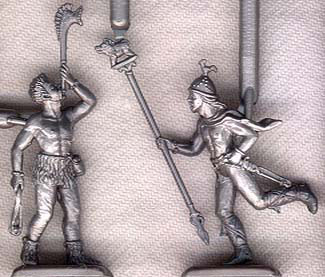 
The musician is playing one of those animal headed horns and holding asling in his other hand. There are several things that spoil another wise good figure, one is the neck of the horn is to short, another is the way the figure is depicted with a piece of fur wrapped around his waist, lastly why the sling?
The standard bearer is running holding a standard with a boar on it. Again another nice figure with well defined detail including a cockerel on his helmet. The pose however lets it down as it is to vigorous.
The spear armed figure is holding it up shaking it. The moulding is so good you can see a leather thong rapped around the spear. The figure is wearing a nicely done winged helmet and on closer inspection seems to be wearing a muscled cuirass that he no doubt captured.
Finally the swordsman. This figure wears chain mail and a helmet and is pointing with his sword. The detail is great you can clearly see his pig-tails and his helmet has a tall spike with tufts hanging from the side. Of the four special figures this is the best the undoubted chief of the tribe.
To sum up an excellent which would have been superb if it had not been let down by having so few variations amongst the poses. Not even the inclusion of separate shields and spears which allow some variation can make up for that basic flaw.
Gallic Armies (updated for DBA 2.0)
There are four possible armies you can make from Gallic/Celt figures.
Not surprisingly these armies have much in common they all can contain the following elements.
- Warband, this is the backbone of all these armies and will be the majority element type in all armies.
- Psiloi - all of these armies can contain one or more of these elements.
- Chariots all the armies can use these but they are optional for most.
- Cavalry optional varying amounts depending on list.
If you want to experiment with the different armies you should therefore get a core force of eight warband, one 4Wb as possible command element,one Psiloi and two chariots,two cavalry. However there will be a problem with this as the Galatians warband are 4Wb while all the rest are 3Wb. You can of course ignore this if you wish.
Similarly ancient Brits use light horse which are two to base not three like the rest of the cavalry. If you put the above core force together you could ignore the wrong number of figures while you try the army out. The Psiloi should be javelin men as these are the most widely used type.
This will provide you with all the force you need to try out a minimalist version of the above armies.
It should therefore not be a surprise that the tactics of all these armies is similar. This can be summed up as getting your warband to the enemy and charging them. The rest of your army is used to make sure this happens by covering flanks and chasing away any pesky skirmishers that may try to slow down your warband. This works fine with opponents who are mostly spears or blades as these are vulnerable to warband (as my poor old Polybian Romans know well) it works less well with other armies.
These tactics can also make your army a bit of an all or nothing force, just like the real thing! Note: all of these armies preferred to be up hill of their opponents, and the ancient Brits tended to defend river crossings. Both of these are good tactics.
So much for what they have in common, now for what makes them all different from each other.
II/11 Gallic 400 BC-50 BC
- 1x3/4Wb or LCh(command),
- 2xLCh or 3Cv,
- 8x3Wb,
- 1x2Ps
In a lot of ways this is your standard Gallic army a good lot of warband with plenty of cavalry/chariots to cover their flanks and some Ps to provide support.
Note the chariots were common only early on and not likely to be used after 100 BC. Psiloi can be archers or slingers.
If the above sound unexciting don't be fooled. This is a nicely balanced force and I have to admit a personal favourite of mine.
Enemies
(I 14e)Northern Barbarian, (I 47) Illyrian, (I 48) Thracian, (I 55d/e) Latin/Umbrian (I 57b) Etruscan league, (30a) Early Roman, (II 10) Camillan Roman (II 11) Gallic, (II 13) Samnite (II 32) Later Carthaginian, (II 33) Polybian Roman, (II 39a/b/c) Ancient Spanish Iberian/Celtiberian/Lusitanians, (II 47a/b/e/f/g) Early German Cimbri & Teutones/Ariovistus/Cherusci/Tencteri/Others, (II 49) Marian Roman, (II 52) Dacians. Allies for big battle games.
(II 39a) Iberian or (II 47b) Ariovistus Figures
Of these you can get figures for all of the Roman armies and the Carthaginians. Hat for early, Camillan and Polybian Roman. Italeri for Marian.
Hat does Spanish infantry and are planning to release cavalry. There are also Lusitanians, Celtiberians and Gauls in Hat's Carthaginian allies set (available soon) however you will also get some less useful Libyans. They also do a set of Thracian infantry. There are no Illyrians however you could use ancient Greece light infantry, Thracians and the Carthaginian heavy infantry with oblong shield. For cavalry lightly equipped Greek cavalry. Alternatively you might try Atlantic's ancient Greeks which have just been re-released though I can't really recommend these as they are not very good.
There are no suitable figures for the Germans except for a few very dodgy ones in the Esci barbarian set. Hat are planning do some.
The various Italian states (Latin, Umbrian, Samnite and Etruscan league) can be supplied by ancient Greeks and Hats forthcoming Roman Italian allies.
II/30 Galatian 280 BC-25 BC
- (a) 280-273 BC
- 1x Lch or 4Wb (command),
- 1xLch,
- 2x3Cv,
- 8x4Wb,
- 1xSch or Lch or 3Cv
- (b) 272-48 BC
- 1x Lch or 3Cv or 4Wb (command),
- 2x3Cv,
- 8x4Wb,
- 1x2Ps
- (c) 47-25BC
- 3Cv (command),
- 2x3Cv,
- 2x4Bd,
- 6x4Wb,
- 1x2Ps
The first two versions of this army are almost all Wb and Ch/Cv this means that you just line them up with the Ch/Cv covering the flanks and go for it. In the earlier version you can have a scythed chariot try using this to break up enemy formations before your main charge goes in.
Note the Scythed chariots were acquired from the Seleucids who got them from the Persians so the chariot in the Italeri/Zvesda Persian cavalry box is just perfect.
The last version shows the Roman influence with the imitation legionaries
This will make you more restrained as you need to slow-down to their pace however they do provide a useful extra attacking force.
Enemies
(a) (I 48) Thracian, (I 63) Paionian, (II 5b/c/d/f) Later Hoplite Greek Athenian/Theban/Thessalian/Phokian,(II 6) Bithynian, (II 14) Ariarathid Kappadokian, (II 18d/e) Macedonian early successor Ptolomy Keraunos/Antigonos Gonatos, (II 19b) Seleucid
(b) (II 14) Ariarathid Kappadokian, (II 19b/c) Seleucid, (II 33) Polybian Roman, (II 34)
Attalid Pergamene, (II 48) Mithradatic, (II 49) Marian Roman.
(c) (II 14) Ariarathid Kappadokian, (II 49) Marian Roman. Big battle allies
None (!) Figures
You should be able to field all these forces using appropriate figures from the following manufacturers:
- Hat: Romans, Greek hoplites, the Alexander the great series, Persians and Thracians.
- Italeri: Romans, Greeks, Persians.
II/53 Ancient British 55 BC-75 AD
- 1x Lch or 3/4Wb (command),
- 2x2Lh,
- 3xLCH or 2Ps or 3Wb,
- 5x3Wb,
- 1x3Wb or 2Ps
This is a much more varied army than the previous ones which allows you to chose the army you field. You can have a army which is fairly well balanced or you can field a lot of Ps allowing you to try a more flexible infantry based approach. Unusually for a Gallic army you can field large numbers of mounted troops allowing you a more manoeuvre based approach to tactics.
Note Ps can be slingers. The javelin armed Ps were inexperienced youth getting some work experience, so use figures without moustaches.
Enemies
(II 49) Marian Roman, (II 53) Ancient Brits, (II 54a) Scots-Irish, (II 56) Early imperial Roman, (II 60) Caledonians. Allies
(II 56) Early imperial Roman Figures
Marian Romans can come from Italeri's Romans with Spanish or Gallic cavalry and Ax /Ps from Spanish, Carthaginian or Ancient Greek sources. Hat will soon be doing a nice range of Early Imperial Romans. Until then you could use Esci Romans and improvise the auxiliaries.
Caledonians do I need to say?
Scots-Irish there are no figures available and none planned as far as I am aware.
II/60 Caledonian 75 AD-211 AD
- 1x Lch or 3/4Wb (command),
- 2x2Lch,
- 8x3W,
- 1x3Wb or 2Ps
This is the simplest of all these armies perfect for typical Celtic tactics of a head long screaming charge into the enemy, preferably down hill. The defeat at Mons Grapus could have been because that's exactly what they didn't do.
Enemies
(II 53) Ancient British (II 54a) Scots Irish (II 56) Early Imperial Rome, (II 64a) Middle Imperial Roman West. Allies
None (!) Figures
There are no figures available for the Irish and the Middle Imperial Romans would be difficult so your choice is limited.
Naked Fanatics
All of the Gallic armies could have a small number of naked fanatics and the earliest armies might possibly have all there warband as naked fanatics. To allow for this I would suggest all armies may use two elements of 4Wb fanatics in place of two normal warband. Your army also has to use its Lch as these and fanatics are from the same period. If you can persuade your opponent to allow it these should have +1 modifiers to reflect their fanaticism. For a more extreme version try making all Wb fanatic with +1 modifiers as an early army.
Finally Gauls can also be found in the following armies
- (II/9) Syracuse warband
- (II/18) Later Macedonian Galatian Warband
- (II/19) Later Seleucid Galatian Warband
- (II/32) Later Carthaginian Cavalry and Warband
- (II/40) Numidia Cavalry
- (II/49) Marian Roman Cavalry and Psiloi
A look through the new DBA 2.0 lists will turn up several more examples.
This is a good way of using up any spare figures you have lying around and it helps to brighten up the other rather dull armies.
As an example of how you can use these figures to build for yourself a Celtic army, have a look at my essay on Creating a Plastic Celtic [DBA] Army.
Stephen
[Thanks Stephen, that's very helpful. If anyone want's to contact the author, please click here.
Nick]
Back to Reviews
[Home] [Plastic Figures] [Buy] [Bulletin Board] [Battles] [Gallery] [Guestbook] [History] [NZ Wargaming] [Painting] [Rules]
This page hosted by
 Get your own Free Homepage
Get your own Free Homepage
|
